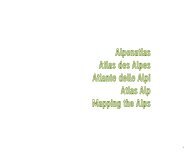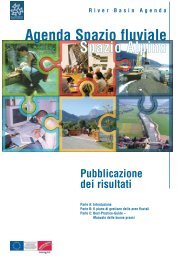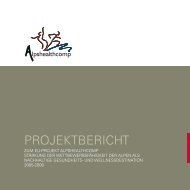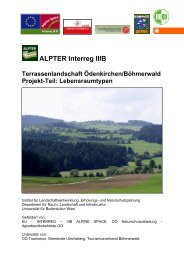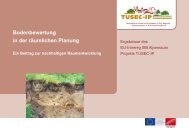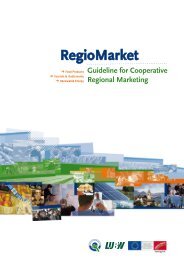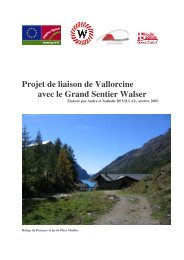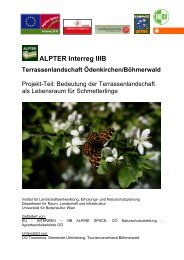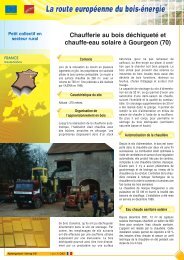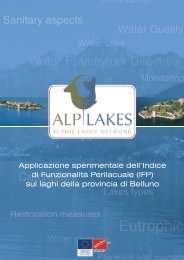WALSERSPRACHE - The four main objectives of the Alpine Space ...
WALSERSPRACHE - The four main objectives of the Alpine Space ...
WALSERSPRACHE - The four main objectives of the Alpine Space ...
You also want an ePaper? Increase the reach of your titles
YUMPU automatically turns print PDFs into web optimized ePapers that Google loves.
Enrico Rizzi<br />
Rima. In <strong>the</strong> Grison Cantons too literary efforts date back to <strong>the</strong> previous century. Valentin<br />
Bühler, a judge from Davos, collected popular songs and proverbs, besides giving us <strong>the</strong><br />
first dictionary and grammar <strong>of</strong> his language. Along with him should be remembered<br />
Georg Fent, Hans Valär and Christian Tester. Johann Joseph Jörger was <strong>the</strong> author <strong>of</strong> short<br />
stories and tales. A small cohort <strong>of</strong> local poets and tale-tellers is still at work both in<br />
Switzerland and in Italy. Too many <strong>the</strong> books on ei<strong>the</strong>r sides <strong>of</strong> <strong>the</strong> Alps to be mentioned<br />
here. <strong>The</strong> best collection from <strong>the</strong> Grison Cantons is Walservolch (1974). Anna Maria<br />
Bacher, a poetess, spanned over all borders with her poetry. Valentin Curta bore witness<br />
to history and traditions in Gressoney, Hans Maria Sartori did <strong>the</strong> same for Bosco Gurin,<br />
Giovanni Giordani gave us a dictionary and tales from Alagna while Johann Rudolf<br />
St<strong>of</strong>fel from Avers also supplied tales. Ancient legends and stories were handed down by<br />
Formazza’s Antonio Ferrera. Toponymy is a rich source for <strong>the</strong> knowledge <strong>of</strong> this language.<br />
<strong>The</strong> best work is by Paul Zinsli. Local singing and popular <strong>the</strong>atre are also a rich<br />
source <strong>of</strong> linguistic knowledge and lore. Apollonia Sartori gave us an entire collection <strong>of</strong><br />
songs in 1889. <strong>The</strong> interest for <strong>the</strong> language and culture <strong>of</strong> <strong>the</strong> Walsers dates back to <strong>the</strong><br />
Renaissance. It was Swiss scholars who first brought public attention to this culture at <strong>the</strong><br />
time <strong>of</strong> <strong>the</strong> Reformation. Bishop Carlo Bescapé from Novara remarked that somewhere up<br />
on <strong>the</strong> Alps <strong>the</strong>y spoke a strange Germanic language. <strong>The</strong> notion it came from Swiss Wallis<br />
worked it way through very slowly. Horace Bénédict de Saussure paid a visit to <strong>the</strong> villages<br />
around Mount Rosa in <strong>the</strong> aftermath <strong>of</strong> <strong>the</strong> French Revolution and he had no doubts as<br />
from whence <strong>the</strong> Walsers came. Linguists followed suit, first Albert Schott and <strong>the</strong>n Joseph<br />
Bergmann. Finally William Augustus Brevoort Coolidge. In Italy it was above all Aristide<br />
Baragiola who studied <strong>the</strong> language and folklore and <strong>the</strong> Walsers from Formazza. A<br />
major testimonial to <strong>the</strong> Walser language is <strong>the</strong> “Schweizerisches Idiotikon. Wörterbuch<br />
der schweizerdeutschen Sprache”. Peter Liver, a law pr<strong>of</strong>essor from Bern, studied Walser<br />
law throughout <strong>the</strong> centuries. Paul Zinsli, also a Bern pr<strong>of</strong>essor, gave us his fundamental<br />
Walservolkstum. Additional works were created by Marco Baeun, Gertrud Frey, Emily<br />
Gerstner-Hirzel, Peter Zurrer, Max Weibel and Kurt Wanner.<br />
49



